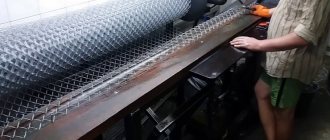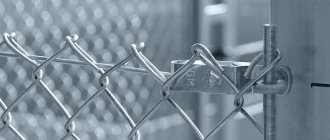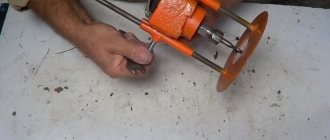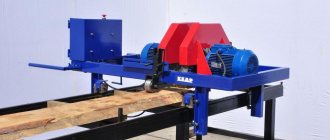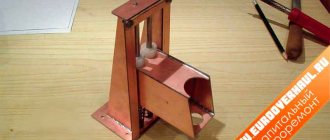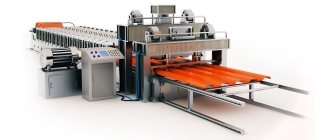When making a chain-link mesh with your own hands, a machine and wire are required. With their help, a spiral is made. The wire should not be curled too much, then the mesh will be smooth and neat. A wire that is too twisted will be difficult to weave into the overall fabric. The mesh will be less distorted and damaged during operation if the machine is lubricated with automobile oil. And better sliding will be facilitated by well-polished and rounded corners and grooves of the machine.
Diagram of wire movement when weaving a mesh.
The machine will help you produce chain-link mesh with your own hands without spending a lot of money on it.
Necessary materials and equipment to create the machine:
- sanding paper;
- file;
- paper;
- metal corners;
- angle grinder;
- welding machine;
- rollers;
- bearing race;
- pieces of iron;
- steel plate;
- part of the pipe.
The bending angle of the mandrel knife.
No matter how you position the machine, the main priority is ease of use.
You need to guide the wire with one hand and rotate the handle of the machine with the other.
You need to make sure that the spirals do not get tangled.
The machine has the following devices:
- serving;
- tension;
- lubricating;
- winding (curling).
What machine is used to make chain-link mesh with your own hands?
When making a chain-link mesh with your own hands, a machine and wire are required. With their help, a spiral is made. The wire should not be curled too much, then the mesh will be smooth and neat.
A wire that is too twisted will be difficult to weave into the overall fabric. The mesh will be less distorted and damaged during operation if the machine is lubricated with automobile oil.
And better sliding will be facilitated by well-polished and rounded corners and grooves of the machine.
Diagram of wire movement when weaving a mesh.
The machine will help you produce chain-link mesh with your own hands without spending a lot of money on it.
Necessary materials and equipment to create the machine:
- sanding paper;
- file;
- paper;
- metal corners;
- angle grinder;
- welding machine;
- rollers;
- bearing race;
- pieces of iron;
- steel plate;
- part of the pipe.
The bending angle of the mandrel knife.
No matter how you position the machine, the main priority is ease of use.
You need to guide the wire with one hand and rotate the handle of the machine with the other.
You need to make sure that the spirals do not get tangled.
The machine has the following devices:
- serving;
- tension;
- lubricating;
- winding (curling).
Feeding device
Industrial knitting equipment will serve as a good wire feeding system. The wire is easily removed from the stationary spool. The steel base of the device is about 1 square. m, thickness 5 mm.
In the center of the base there is a steel pin approximately 1 m long. Several rods with a diameter of about 1 cm are welded to the pin. At the very top of the pin a bearing with a driver and a ring is installed.
The wire from the feeder is passed through the ring and inserted into the tensioning mechanism. The tension system consists of rollers and a lubrication mechanism. The rollers create the necessary wire tension.
Stretching device
The frame is made in the form of a right triangle. The hypotenuse of the triangle should be a steel plate 5 mm long and 7 cm wide, and the other two sides are made from angle steel.
Special holes are made in the hypotenuse plate where the rollers are installed. The screw helps change the distance between them.
It is advisable to make about 30 such holes, this will create the necessary tension on the wire.
Lubrication device
Tool for forming a spiral.
The lubricating device must be installed on a plate with rollers. It can be made from a bicycle pump.
You need to attach the pump to the plate so that the bottom is at the top. The bottom needs to be cut off. In this case, the pump cover should easily fit onto the housing, securing the felt plug in it.
The cork must be cut so that the knots on the wire can easily pass through it. Machine oil is poured into the pump itself.
To ensure that the pump wall is not damaged during operation of the machine, it is necessary to ensure that the wire enters the tube without touching the edge.
For reliability, you can strengthen the edges with a stronger material, for example, install a bearing cage.
Winder
It is necessary for the machine to form a good spiral, so the winding mechanism is its main part. This device consists of a pipe with a spiral-shaped slot and a special knife.
Spiral groove pipe dimensions.
They create the required size of grid cells. These parts wear out very quickly, so for mesh production it is better to take parts from stronger metals. The spiral turns are created by turning the knife, and the pipe creates the distance between them.
If you take a pipe with a diameter of 4 cm, then the spiral pitch will be 1.75 times larger, it will be equal to 7 cm.
To create a slot on a pipe, you need to take paper about half a meter long and 7 cm wide, grease it with glue and carefully wrap it around the pipe, leaving a gap of 4 mm. There should be at least 3 turns for the entire length.
All that remains is to make cuts along the gap line and sand the edges with sanding paper. Instead of a pipe with slots, you can purchase a screw sleeve.
In order to complete the creation of the device, you need to select a steel corner with 2 cm shelves. The corner needs to be cut into two parts equal to the length of the pipe. The corners are welded to the pipe on both sides. The entire structure is attached to a base with holes so that it can be conveniently attached to the table.
It is possible to create several winding devices with different cell pitches.
For ease of operation of the machine, it is advisable to stop curling when the end of the wire still remains in the winding device. Otherwise you will have to reinsert the wire.
This is a rather complicated process: you need to bend its end, hooking it with a knife, and then slowly turn it, inserting the end into the pipe slot. In this case, the wire must be pressed with a screwdriver so that it does not get bitten.
It is necessary to help with a screwdriver until the wire appears on the other side of the machine.
Wire winding knife
For soft wire, you will need a flat knife, and for stiffer wire, the knife must have a large twist angle.
A knife for hard wire must be made of durable metals, but for a flat knife any kind will do. The knife must fit exactly the dimensions of the pipe so that there are no gaps. This may cause the mechanism to jam. However, the knife should rotate in the pipe without difficulty.
For a twisted knife, you need to take a plate 1-2 mm wider than the required size. It is clamped vertically in a vice, heated and the upper part is turned to the required limit. The untwisted parts are cut off, the shank is attached, and then the required width is adjusted.
Part of the knife near the shank is hardened, and the rest is ground.
When producing mesh, the machine must be stopped when the knife is positioned vertically.
And the correct position of the spirals during connection is facilitated by the position of the bottom wire in the desired direction, using the table board for installation.
Elastic wire can be annealed to make it more obedient. But this requires special skills, otherwise you may end up with different stiffness along the entire length.
You must remember to change the knife if, after working with a stiff wire, you have to curl a less rigid one. Also, their step length will be different, so you need to screw in the spiral more carefully.
Editing table and its use
Before starting work, it is recommended to check the winding device. One end of the wire is inserted into the device and scrolled several times. The result should be a spiral with good cell shape. To check the evenness of the cells, you need to look in a suspended state. If protrusions are noticeable in different directions, this can be adjusted using rollers.
To make a chain-link mesh, it is necessary to remove the wire from the feed mechanism through the ring and pass it through the tension device, directing it into the winding mechanism, creating a new spiral.
Having chosen the correct location of the rollers, you need to ensure that the spiral comes out flat.
In the editing table, you need to move a special board, inserting a spiral into the opened space so that the left turn interlocks with the first turn of the other spiral. After this you can turn on the installation. When the spirals are intertwined, you need to separate the spiral of the required length and, interlocking their turns, turn on the installation again.
If you use a large cage to weave a chain-link mesh, you can create up to 100 m of chain-link per day. If a lot of spirals are produced, and there is no need for a mesh, then you can simply fold them carefully without weaving the fabric. They will not take up much space, and in the future you can weave them into a chain-link mesh of different lengths, cutting and joining in the necessary places.
Types of gabions - shapes and designs
There are 3 main groups based on the shape of the frame:
- Cylindrical;
- Flat;
- Box-shaped.
The most popular option is box-shaped.
Material selection
For the frame used:
- Rabitz;
- masonry mesh;
- reinforcement grids.
To create the frame, we can use any rigid materials. The main thing is that they can be tied with wire or welded with an electrode.
Do-it-yourself machine for making chain-link mesh - diagram
The production of chain-link mesh is the simplest business for home conditions. This business idea requires small financial investments.
You can organize the profitable production of chain-link mesh at home using homemade equipment (drawings are described below). Over time, you can purchase ready-made automatic machines.
The production technology is one of the simplest. Start your own production in three steps:
- Buy wire.
- Using a machine, weave a roll of chain-link.
- Sell the product at market value.
Business profitability from 70%. Chain-link mesh is a building material, which means it has seasonal active sales (6 months) and constant demand. It is impossible to replace it on the farm with cheaper fencing material. Let's take a closer look at all the stages of organizing the simplest home business.
Do-it-yourself manual machine for weaving a chain-link mesh
We make a machine for a chain-link mesh with our own hands. To understand the operating principle of coiling machines, let’s first analyze the design features of the finished product.
How to make a chain-link mesh with your own hands at home? The chain-link mesh is a chain of springs. Each individual line of the chain-link mesh has the shape of an oval spring when viewed from above (from the end side).
During the process of forming a spring from wire, a second operation of weaving it into the previous spring simultaneously occurs. In this way, the whole fabric is woven. This simple operating principle of the machine during production allows you to produce high-quality chain-link mesh at home.
The only limitation is the performance, which is at a satisfactory level.
To form oval springs from wire, it is necessary to make a coiling base from durable steel. As well as a screw sleeve, which sets the same pitch of turns. Together, these two parts form a spiral winding device, which is the basis of the operating principle of the machine. The winding bar is quite easy to make, as shown in Figure 3.
And the sleeve is a more complex part. It should be made of a metal pipe with an outer diameter of 55mm. Along the entire pipe it is necessary to turn a spiral groove at an angle of 45 degrees on a lathe. Groove pitch 72mm. The width of the channel in the groove is 7mm.
Now you need to correctly connect these two parts by placing the wound base inside the sleeve with a spiral channel. In order for the bar to rotate freely inside the sleeve, it is necessary to accurately match their axial centers. Making a stand and rack will help achieve a solution to this problem. The sleeve is connected to the stand by a weld.
And the bar with the stand is hingedly connected, as shown in the figure. A handle or pulley for pass transmission from an electric motor is connected to the hinge.
The machine is fixed on the table so that the length of the table is no shorter than the length of the turns. By rotating the winding base (bar), wire is wound onto it with the correct bends and pitch of the coil, which provides a spiral channel in the sleeve.
The wire moves along the bar and, rotating, is woven into the previous turn. After reaching a certain length, it is cut off with metal scissors. The process is then repeated cyclically until a web of the required roll length is formed.
To make this device you do not need drawings, just look at the schematic representation of the operating principle. And the sizes of the nodes depend on the desired cell sizes in the finished product.
Chain-link mesh is always in demand on the building materials market. Of course, its demand is sensitive to seasonality. But in the period from April to October, the sale of fish netting is characterized by good stability. According to marketing analyzes of building materials, chain-link mesh is purchased in 85% of cases for the construction of various types of fencing. For example:
- fencing at construction sites and summer cottages;
- construction of enclosures for agricultural species of birds and animals;
- production of sapetkas for storing hay and some types of feed or firewood.
10% of the needs relate to construction. For example:
- reinforcement for plastering work;
- pipeline protection;
- strengthening relief slopes.
The remaining 5% is used for other less popular purposes.
The price of the grid is formed depending on certain conditions:
- Design features: diameter of wire section; size and shape of cells.
- Type of consumables: galvanized metal; stainless steel; aluminum; with polymer coating; ordinary low carbon metal.
- Roll size (length height).
The pricing factors described above determine the range of products produced. For example, it is easy to attract buyers today with polymer-coated chain-link mesh. Wider assortment = more sales.
Profitability of mesh production
The profitability of a home business for the production of chain-link mesh is at an attractive level for investment. Retail cost of a standard roll of chain link (10 x 1.5 m.
) made of thick galvanized wire 1.6 mm and cell cross-section 55x 55 mm is $17. 1 kg of galvanized wire 1.6 will cost $1.
Its consumption for production should be calculated using the following formula: (13.40 * D2)/A = Xkg/1m2. Indicator value:
- 13.40 kg/mm – constant;
- D – wire diameter in mm;
- A – cell diameter in mm;
- X – kg per 1 m2 of canvas.
That is: (13.40*1.6?) /55 = 0.62 kg. We have 15 m2 per roll, which means 0.62 * 15 = $9.3 – the cost of 1 roll. Now it’s not difficult to calculate the profit of $17 - 9.3 = $7.7 from one standard roll of galvanized mesh.
Advantages of producing chain-link mesh at home
This business idea is ideal for organizing home production due to a number of reasons. A business with small investments is determined by the following factors:
- The machine has a simple design and can be made by hand.
- The cost of consumables (wire, lubricant) is also very affordable for the first sales. Further, the business should be developed by investing earned money in it.
- Large areas are not required when organizing production. The mesh is wound into rolls and does not take up much space.
- Average performance. This is a rare degree of productivity for a home business. In 1 hour, a beginner can produce 2 standard rolls of chain-link.
It should also be noted that with such comfortable conditions for creating a business, its profitability remains at a good level. On the building materials market you can find plastic netting.
But plastic will not be much of a competitor to metal fencing. Indeed, in 85% of cases it is used for fencing.
While plastic mesh chain-link has its own disadvantages for fencing purposes:
- higher cost;
- low strength;
- zero fire resistance;
- fades in the sun.
In addition, a mesh with a polymer coating will not yield to many advantages of the plastic material. Organization of home production of chain-link mesh on a homemade machine, which you can make yourself according to the drawings.
How to decorate a chain-link mesh with your own hands photo
And for dessert, a few original solutions for decorating mesh fences. Look how original you can decorate a grid using: colored polypropylene tape, painted plastic bottles and Kinder Surprise boxes:
Chain-link mesh can also be used in landscape design:
The scope of application of such meshes is much greater than it might seem at first glance. Accordingly, this fact has a direct impact on the demand for goods in the construction market.
LiveInternetLiveInternet
-Music
—Categories
- Stencils (48)
- A (16)
- A - THIS IS A TRANSLATOR OF TEXT PAGES (5)
- AND THIS IS INTERESTING. (60)
- AND I NEED THIS NOW (62)
- ALOE (11)
- Angels (21)
- ENGLISH LANGUAGE (22)
- PANSIES (19)
- ARTISTS (TO BE REMEMBERED) (43)
- Grandma's TREATMENTS (36)
- Continuous Knitting (29)
- BEAD MK (385)
- BEADED DIAGRAMS (419)
- beading (403)
- DIVINE HOLIDAYS (PICTURES WITH CODES) (54)
- MASTERITZ ACTIVITIES (45)
- BROOMSTICK (50)
- BRUGGE CROUSE (91)
- TO THE PIGGY BANK (436)
- TO THE PIGGY BANK (313)
- INSPIRATIONALS (23)
- VIDEO RECIPES. (80)
- VIDEO KNITTING (636)
- VINTAGE FRAMES (97)
- STAINED GLASS AND STAINED GLASS MK (20)
- hair (123)
- collars (108)
- ALL TYPES OF BAKER (39)
- ALL TYPES OF TEST (102)
- everything for Easter (5)
- ALL FROM PAPER, CARDBOARD. (45)
- All about Lyra (205)
- ALL ABOUT HONEY (38)
- EVERYTHING (6)
- PATTERNS (197)
- BAKERY (20)
- RIBBON EMBROIDERY (162)
- WE KNIT ARANS (9)
- KNITTING (197)
- KNITTING (IDEAS) (423)
- KNITTING - learning to crochet (42)
- KNITTING - learning to knit with KNITTES (31)
- crochet (979)
- CROCHET (winter) (22)
- CROCHET (summer) (275)
- CROCHETING (PATTERNS) (86)
- TAPE KNITTING (53)
- KNITTING MK AND MASTER CLASSES (219)
- knitting (271)
- KNITTING (winter) (62)
- KNITTING (summer) (17)
- KNITTING (PATTERNS) (65)
- KNITTING PATTERNS (461)
- TUNISIAN KNITTING (90)
- KNITTING SHORT ROWS (4)
- LOINT KNITTING (35)
- FREEFORM KNITTING (46)
- KNITTING "PINEAPPLES" (11)
- KNITTING(ROMANIAN LACE.) (114)
- KNITTING(POCKETS, etc., etc.) (101)
- KNITTING (READING PATTERNS SYMBOLS) (56)
- KNITTING, ALL CRIB SHEET TO HELP KNITTERS (113)
- KNITTED BED (96)
- KNITTED COATS AND CARDIGANS (296)
- Knitted buttons. (16)
- KNITTED RIBBERS (104)
- KNITTED CORDS (77)
- knitted jewelry (543)
- GANUTEL (59)
- HOROSCOPE (68)
- WE COOK IN POTS. (4)
- WALNUT JAM, etc. (11)
- mushrooms (50)
- DECORATION AND PAINTING OF BOTTLES (73)
- Decoupage (161)
- DECOUPAGE MK OR MASTER CLASS (236)
- DECOUPAGE_PICTURES FOR DECOUPAGE (437)
- WE MAKE CANDLES AND CANDLESTICKS (19)
- denyushki (96)
- DESSERTS (230)
- KIDS (61)
- CHILDREN (BLANKETS FOR THEM) (196)
- CHILDREN (fun and games) (3)
- CHILDREN'S HATS (15)
- JONGSAN@ JONGSAN (16)
- DIET - WILL WE LOSE WEIGHT? (80)
- for children (926)
- For kids (607)
- FOR CHILDREN WINTER (155)
- CHILDREN'S BAPTISM DRESSES (25)
- FOR CHILDREN SUMMER (205)
- BOOTIES FOR BABIES. (112)
- FOR HOME (308)
- for luck (76)
- HOMEMADE BREAD (21)
- HOME AND CHILDREN'S MAGIC (26)
- JACQUARD PATTERNS (102)
- PAINTING (178)
- LIVE FLOWERS (81)
- conspiracies. (97)
- here you will find a lot of interesting things (108)
- HEALTH (393)
- HEALTH MK (52)
- umbrellas (108)
- PASTA PRODUCTS (22)
- GINGER AND ALL FROM IT (14)
- INTERESTING TIPS FOR WOMEN (175)
- Irish lace (663)
- IRISH LACE VIDEO (64)
- Confessional (57)
- for tea (537)
- CACTUSES AND ROSES (16)
- KANZASHIKI (89)
- PORRIDGE IS OUR STRENGTH. (3)
- QUILING (41)
- BRUSHES AND THEIR PURPOSE (68)
- KNITTING BOOKS (226)
- comments (150)
- canning (233)
- CRACKELURE (27)
- beauty (40)
- cookie creams (74)
- Cereals and their beneficial properties.. (17)
- DOLLS (42)
- SWIMSUITS (106)
- CUISINES OF THE WORLD (68)
- kitchen (354)
- KITCHEN(CHICKEN DISHES) (166)
- LEAVES, FLOWERS THAT TREAT (53)
- PATCH BLANKETS (17)
- HORSES (67)
- ONION PEEL (6)
- M-O-R-O-J-E-N-N-O-EEEEEE (20)
- MAKEUP (75)
- MACRAME (37)
- MOM (29)
- MASTER CLASSES AND MK (127)
- MATRYOSHKA POSTS (20)
- FUR KNITTING (42)
- eggshell mosaic (23)
- PRAYERS (122)
- PRAYERS DREAMS OF THE HOLY VIRGIN (13)
- MOTIVATORS (22)
- My cookbook (97)
- music (368)
- MUSIC CHANSON (17)
- MUSIC-CLASSICS (0)
- CARTOONS (51)
- SOAPS AND PERFUME (101)
- SOFT TOYS (WE SEW OURSELVES) (127)
- DRINKS (41)
- DRINKS (93)
- WEIGHTLESS PICTURES (ON FEATHERS) (18)
- NON-CONVENTIONAL TREATMENT (5)
- NEW YEAR'S KITCHEN (26)
- NEW YEAR (130)
- SOCKS (263)
- NEEDS, USEFULITIES (117)
- CHARMS (26)
- shoes (161)
- VEGETABLE GARDEN (planting, shoots) (52)
- DIARY CLOTHES (143)
- papier mache (23)
- EASTER (67)
- EASTER-BAKING (42)
- PERGAMANO (6)
- translator (3)
- TRANSLATIONS FOR KNITTING (9)
- ALTERATIONS (38)
- SAND (11)
- PLASTIC BOTTLES (16)
- SCARVES (HOW MANY USES IT HAS) (13)
- newspaper weaving (198)
- FOIL WEAVING (4)
- let's tell fortunes (29)
- salt dough crafts (27)
- CONGRATULATIONS FOR ALL OCCASIONS OF LIFE (19)
- BEDDREADS (5)
- HEALTHY PRODUCTS (15)
- useful tips for computer (79)
- PLASTIC BAGS. (25)
- Let's have fun? (134)
- SIGNS (7)
- SEASONINGS (11)
- PARABLES (41)
- HAIRSTYLES (39)
- SHELLS (7)
- HAPPY BIRTHDAY FRAMES (38)
- FRAMES (489)
- DRAWING VIDEO LESSONS (49)
- draw on stones (27)
- draw on stones (41)
- DRAWING WITH HENNA (3)
- RITUALS (3)
- CHRISTMAS. (6)
- Daisies (18)
- RUNES (946)
- RUSSIAN TSARS (20)
- Fish (110)
- SALADS (115)
- SEAFOOD SALADS (10)
- NAPKINS (241)
- WEDDING BOUQUETS (14)
- SECRETS OF HEALTH (INUSIONS AND ALL RECIPES) (202)
- TALES (323)
- TALES-2 (79)
- TABLECLOUTS (63)
- SKELETING LEAVES (9)
- SCRAP KITS (122)
- SNOWFLAKES (76)
- SAUCES (23)
- poems (427)
- bags (155)
- KNITTING PATTERNS (81)
- CHEESE (13)
- FABRIC AND KNITTING (97)
- STOT PAINTING (135)
- Stencils and WHAT NEEDS TO BE XERIED (593)
- TURKISH HARNESSES (100)
- STUDY FROM 1ST TO 11TH GRADES (37)
- LEARNING TO DRAW (37)
- Baubles (112)
- A LOT OF FILM IN ONE BOTTLE))) (140)
- MOVIES (77)
- MOVIES and CARTOONS FOR CHILDREN (57)
- MOVIES ONLINE (107)
- MOVIES-SERIES (75)
- FOIL (5)
- FENG SHUI (15)
- cold porcelain (543)
- COLD PORCELAIN (ALL YOU NEED FOR THIS) (38)
- CLEAN (70)
- WONDERS OF THE WORLD (98)
- shawls (181)
- SCARVES,SNOODS (63)
- Hats (398)
- BEADED CURTAINS (44)
- this is interesting (series of messages) (77)
- EGGSHELLS (21)
Chain-link mesh manufacturing technology
The production of chain-link mesh is the simplest business for home conditions. This business idea requires small financial investments.
You can organize the profitable production of chain-link mesh at home using homemade equipment (drawings are described below). Over time, you can purchase ready-made automatic machines.
The production technology is one of the simplest. Start your own production in three steps:
- Buy wire.
- Using a machine, weave a roll of chain-link.
- Sell the product at market value.
Business profitability from 70%. Chain-link mesh is a building material, which means it has seasonal active sales (6 months) and constant demand. It is impossible to replace it on the farm with cheaper fencing material. Let's take a closer look at all the stages of organizing the simplest home business.
History of appearance and characteristics
Rabitz mesh is named after its German inventor, Karl Rabitz, who received a patent for the material and for the machine for its production in 1878. Other sources say that chain-link was invented by Charles Bernard of Great Britain in 1844. In any case, this building material has remained in demand for more than 140 years.
Galvanized mesh fabric
Mesh fabric is made by screwing wire spirals into each other on simple machines. The raw material for it is low-carbon steel wire. More expensive types of building materials are made from galvanized or polymer-coated wire.
The shape of the cells is rhombic or square. The mesh is supplied in rolls of 10 meters or more in length, with a width from 70-80 cm to 4 m. Its strength depends on the mesh size and the diameter of the wire: the smaller the mesh and the thicker the fiber, the stronger the mesh will be.
What is a chain-link mesh?
There is an assumption that the name “chain-link” is a distortion in Russian of the English word “rabbit” - rabbit. That is, a “rabbit net”.
Apparently, the mesh made using this technology was originally intended for cages in which rabbits were kept, or for fences that did not allow rabbits into any territory.
Chain-link mesh is made by winding lines from wire in the form of flat springs. (Fig.1)
Fig. 1 A line in the form of a flat spring is an element of the chain-link mesh fabric
Such stitches are obtained when the wire is wound in uniform increments onto a flat ruler. (Fig.2)
Fig.2 Winding wire onto a flat ruler to obtain a stitch
The width of the ruler determines the cell size of the chain-link mesh. Then, one line is screwed into another, and a grip is obtained along the protrusions of the line. (Fig.3)
Fig.3 A chain-link mesh line screwed into the previous line.
Demand for mesh
Chain-link mesh is always in demand on the building materials market. Of course, its demand is sensitive to seasonality. But in the period from April to October, the sale of fish netting is characterized by good stability. According to marketing analyzes of building materials, chain-link mesh is purchased in 85% of cases for the construction of various types of fencing. For example:
- fencing at construction sites and summer cottages;
- construction of enclosures for agricultural species of birds and animals;
- production of sapetkas for storing hay and some types of feed or firewood.
10% of the needs relate to construction. For example:
- reinforcement for plastering work;
- pipeline protection;
- strengthening relief slopes.
The remaining 5% is used for other less popular purposes.
The price of the grid is formed depending on certain conditions:
- Design features: diameter of wire section; size and shape of cells.
- Type of consumables: galvanized metal; stainless steel; aluminum; with polymer coating; ordinary low carbon metal.
- Roll size (length height).
The pricing factors described above determine the range of products produced. For example, it is easy to attract buyers today with polymer-coated chain-link mesh. Wider assortment = more sales.
Premises requirements
To organize your production, you will need to select the appropriate premises. One automatic or semi-automatic line requires from 15 square meters for its placement.
Depending on the planned number of machines, it is necessary to calculate the total area. One of the important conditions is the presence of three-phase voltage in the workshop.
In addition to production facilities, storage facilities for finished products and raw materials will also be required.
Wire weaving. Working with wire mesh
Tuesday, October 02, 2012 23:57 + to quote book
Wire weaving. Working with wire mesh
Wire weaving. Working with wire mesh.
Wire mesh is a wonderful material because it is cheap, attractive and easily available. Its flexibility and lightness make it suitable for large-scale structures, which is why it is often used by sculptors. For simplicity, below we will call the horizontal (double twisted) sides of the hexagonal mesh cells twists, and the single sides - cores. It is recommended to wear gloves when working with wire mesh. Finish any project made from chicken wire by removing any sharp ends that stick out.
How to make a machine for making chain-link mesh with your own hands and what offers are on the market
Chain-link is a woven metal mesh with cells in the form of rectangles or diamonds. It is widely used for the manufacture of fences or enclosures. The main advantages of the material are low price, ease of installation, and structural strength.
A machine for chain-link mesh can be easily purchased, but some craftsmen prefer to make the equipment with their own hands.
A machine for making chain-link mesh will help us reduce costs during mass production
Types of equipment
Before you make a purchase, you need to know the advantages and disadvantages of different types of devices. There are three types of chain-link mesh production machine: manual, semi-automatic and automated.
Hand tools
Such devices are best suited for personal use. The equipment is compact and can be easily placed in a small room. This chain-link machine makes spiral-shaped blanks from wire, and weaving the mesh is done by hand.
The structure includes a frame and a screw. The latter is presented in the form of a bending shaft. The movement is carried out by rotating the lever; more advanced models are often equipped with a gearbox, which facilitates the procedure. While moving, the screw makes spiral blanks from wire.
Before starting work, you need to cut the wire into equal lengths. The length of the workpieces determines the height of the mesh; the size of the cells depends on the parameters of the screw, which are selected individually for each case.
In this video we will look at how to make a chain-link mesh with your own hands:
The maximum wire diameter that can be worked with manual equipment is 3 mm, the mesh size varies from 30 to 60 mm. An experienced worker can weave about 50 m of mesh in one shift. It should be noted that such structures are not designed to work on an industrial scale , because they have a low safety margin.
The purchase of equipment is justified if you plan to install fencing at home.
The best option on the market today is the BMP machine. It is simple and reliable in operation, characterized by compactness and light weight; the operator does not require special skills before starting work. The price of such a unit is about 17-20 thousand rubles.
Semi-automatic device
The most famous semi-automatic machine for the production of chain-link is ACP 15/2. The operation of the device must be under the control of an operator , who not only monitors the production, but also takes a direct part in the process. The equipment is characterized by ease of operation, ease of setup, compact dimensions and low cost.
The device can be used on production lines that are located in small areas. The unit independently bends the ends of the wire, winds the fabric, stops and cuts.
The device is a modern, improved model, has high performance, and is much quieter than its predecessors.
The machine makes products that meet all the requirements of GOST 5336-80. The mesh is produced with cell sizes from 2 to 6 cm, knitting is carried out in one wire. With such indicators, setting up the device is quite simple. The height of the finished chain-link roll is no more than 2 m, however, you can configure the equipment so that the maximum length is 3 m.
The production of building materials is carried out under microprocessor control. The system is equipped with a continuous supply of fluid for lubrication and cooling. With their help, the operating life of the device is at least 1000 rolls.
If production failures occur (wire jams), the system stops, but the established settings are not lost.
Advantages of ACP 15/2
The model is easy to operate and reliable in operation. One operator can simultaneously service several identical installations. The device has a number of positive characteristics:
- Reliable operation of the mechanical part is due to the use of a one-piece gear motor design instead of individual parts.
- The coolant is supplied using an emulsion pump. As a result, the service life of the device is significantly increased.
- The guide bushings that supply the source material are equipped with inserts made of hard alloys, so they do not require replacement during the entire operating time of the device.
- The machine is equipped with a special system that improves weaving performance. This function is achieved due to the reduction of downtime between technical stages in the operation of the machine.
- The unit does not require fastening to the floor during installation.
- ACP 15/2 is characterized by high maintainability.
After purchasing the equipment, it pays for itself within 2-3 months, which is a consequence of the high productivity of the machine.
Complete with the device, the manufacturer includes a special unwinding mechanism, a model passport and other technical documentation, as well as 2 sets of equipment, each of which consists of a winding plate, a receiving pipe and a screw bushing.
Automated designs
The automatic spa equipment has proven itself well; a machine is used for the production of chain-link with cells in the form of squares and rhombuses ranging in size from 2 to 6 cm. For the production of mesh, the starting material is galvanized and black wire with a diameter of 1-3 mm.
All production stages are carried out automatically, without human assistance. The operator only needs to visually monitor the work process and carry out the initial setup of the settings.
Automatic unwinding of the source material, weaving of the chain-link, one-sided bending of the ends, and winding of the finished building material into a roll occur. In addition, the unit stops if the wire gets tangled in the spool or guide pipe. The device kit includes:
- three sets of matrices that allow you to create a grid with cells of different sizes;
- cooling system;
- device for unwinding wire;
- guide tubes;
- registration certificate;
- user manual.
Select a mesh production machine depending on your production needs
The peculiarity of the devices is their performance and size. For example, the SPA-01 machine can produce 70 m2 of chain-link in an hour, and the SPA-04 can produce at least 180 m2. All models are equipped with a programmable controller, which sets the program for settings and controls the functioning of the machines.
To facilitate unloading and delivery of the unit, the winding mechanism can be detached and transported assembled.
In addition, the electrical part is initially placed separately; its installation is carried out directly at the site where the material will be manufactured.
Mesh production on units
Before starting work, the operator loads the wire into the receiver and sets a program for the controller, entering the required mesh parameters into the device’s memory. After these manipulations, the system starts up.
During operation, the wire from the coil in the receiver is unwound with a special device and pulled to the machine, where blanks are formed from it. The process is carried out by winding the source material onto a screw.
The finished spirals are sent to the guillotine for further trimming. Next, one end is bent into the shape of a hook. The length of the latter is equal to half the size of the cell.
The resulting workpieces are pulled through a continuously rotating shaft. The gripping device holds the coil and stretches it under pressure. Then the next workpiece is woven into the one being held.
This is how cells are formed. When a new piece of source material is ready, the previous piece is released and wound into a roll. When the required length of the latter is reached, the material is sent for automatic treatment with lubricants, and then to the warehouse.
Making the device yourself
Making a hand-held device yourself is not as difficult as it seems at first glance. First you need to make a winding bar from steel; its dimensions are shown in the diagram.
This design will be able to form spiral blanks for a mesh with cell sizes of 5x5 cm - these are the most common parameters. In addition to the bar, you need to make a winding device with which the pitch will be set.
To do this, you need a metal pipe with an internal diameter of 35 mm and an external diameter of 50 mm. Then spiral-shaped grooves are made on it, the width of which is 7-8 mm, the pitch is 72 mm. The work can be carried out using a grinder or a lathe.
The next step is to put on the coiling structure and attach it to the bar. The resulting workpiece should rotate and be fixed freely. The best option is to install it on ball bearings or make a stand from a profile.
: installation of a fence made of gitter mesh.
After carrying out the described manipulations, all the parts are assembled into a single structure and then mounted on the corner of the table. The technology for producing chain-link is simple: the end of the wire is inserted at a right angle into a groove on the bar, then rotation is carried out using a handle, as a result of which the source material is bent to the specified dimensions.
A machine for making mesh netting is a popular piece of equipment with which you can organize your own business. At the initial stage, capital investments will be required to purchase the device, but if you organize sales of finished products, the purchase will soon pay off.
Review of the design of a manual machine for the production of chain-link mesh
Chain-link mesh is considered a truly universal building material. It is used in the construction of buildings, for the formation of fences, as well as in landscape design. To save money, you can make a machine for making chain-link mesh with your own hands.
Choosing the shape and material of manufacture for the chain-link mesh
It consists of several pieces of wire of a certain shape, woven together. The main material is galvanized or black steel. The wire diameter can be from 0.5 to 2 mm depending on the model. Performance properties are also taken into account.
To produce a chain-link mesh with your own hands, you must select the shape of the cells in advance. It depends on the application as well as the required technical characteristics. There are currently two accepted cell forms:
- rhombic. The wires are located at an angle of 60 degrees relative to each other;
- square. Characterized by right angles relative to the connecting elements.
It is also necessary to select the optimal height in advance. It is noteworthy that the machine will not affect this parameter. But the shape of the cells depends on it. The height can vary from 0.5 to 2 m, but the rigidity of the structure must be taken into account. If it is used as a fence, the height will usually be 1.5 m.
The optimal length of a do-it-yourself chain-link mesh roll is usually 5 m. This will allow you to install the material without increasing the labor intensity of the work.
Production stages of a chain-link mesh machine
To make a machine with your own hands, you need a minimum of skills and a small number of tools. It is important to draw up the drawings correctly. To do this, first an audit of the available material is carried out, and then, based on the data obtained, a scheme for the manufacture of equipment is formed.
At the first stage, you need to become familiar with the general technology. It consists of controlled deformation of steel wire for further weaving. Technologically, this is carried out in two stages. First, the workpiece is aligned, and then, using a special block, the wire is bent at a certain angle.
To carry out these processes, do-it-yourself chain-link mesh production equipment must include the following structural components:
- wire straightener. It consists of three small shafts. The outer ones serve as a support, and the one in the middle is designed to level the workpiece. Its positions must be adjusted relative to other shafts. The block is manufactured separately from the main machine;
- homemade machine for forming structural elements. It consists of a pipe with a diameter of 60 mm, inside of which there is a plate. A handle is attached to one part of it by welding. Angular spiral cuts are formed on the surface of the pipe, the distance between which will determine the future dimensions of the cell. Usually it is 5-7 cm.
To increase productivity, the wire deformation unit must have a platform. Most often, a steel plate is used for this, the dimensions of which exceed the diameter of the pipe by 2-3 cm. Holes are drilled in it for mounting on a desktop.
Additionally, a lubricating fluid supply unit is installed on the leveler. It is necessary to reduce the likelihood of marriage.
If it is necessary to increase the production speed, an electric motor is installed instead of a manual drive. However, it is necessary to consider a mechanism for reducing speed.
Plastic
Making mesh out of plastic is a little more difficult, since it will need to be heated over an open fire. And here, the main thing is not to overdo it.
You will need the following materials; plastic tape about 4 mm wide. An alternative can be a tube with a radius of 1-1.5 mm. You can make both from a plastic bottle. A board, burner, or alcohol lamp.
You need to draw squares evenly on the board. They will serve as markings for the tape. The ends of the tape need to be attached to the board.
Wrap the plastic tape around the board and simultaneously heat it over the fire for about 60 seconds. Warm it over the fire again, first fixing the edges. Well, then, as in the previous method, we connect the finished curls together.
Check it out here too!
- Do-it-yourself trolley - how and from what to build a decorative and tool trolley (135 photos and videos)
DIY nests for laying hens: drawings, tricks, best solutions and tips on how to make nests correctly (115 photos and videos)
How to hem felt boots with your own hands: materials, tools, useful tips for hemming. Step-by-step instructions with photos + master class with video!
